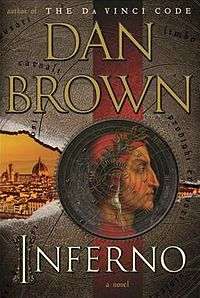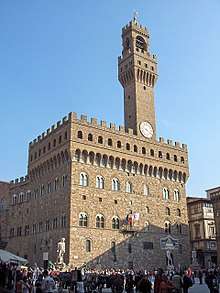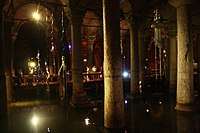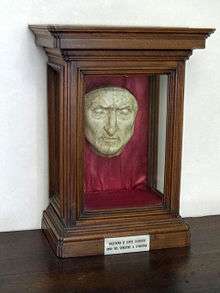Inferno (Brown novel)
 First US edition cover | |
| Author | Dan Brown |
|---|---|
| Country |
United States United Kingdom |
| Language | English |
| Series | Robert Langdon #4 |
| Genre | Mystery, Conspiracy fiction, Thriller |
| Publisher | Doubleday |
Publication date | May 14, 2013 |
| Media type | Print, e-book, movie |
| Pages | 609 pages |
| ISBN | 978-0-385-53785-8 |
| OCLC | 824723329 |
| Preceded by | The Lost Symbol |
| Followed by | Origin |
Inferno is a 2013 mystery thriller novel by American author Dan Brown and the fourth book in his Robert Langdon series, following Angels & Demons, The Da Vinci Code and The Lost Symbol. The book was published on May 14, 2013, ten years after publication of The Da Vinci Code (2003), by Doubleday.[1] It was number one on the New York Times Best Seller list for hardcover fiction and Combined Print & E-book fiction for the first eleven weeks of its release, and also remained on the list of E-book fiction for the first seventeen weeks of its release. A film adaptation was released in the United States on October 28, 2016.
Plot
Harvard professor Robert Langdon wakes up in a hospital in Florence, Italy with a head wound and no memory of the last few days. Dr. Sienna Brooks, one of the doctors tending to him, reveals that he is suffering from amnesia. When Vayentha, a female assassin, shows up in the hospital and kills Dr. Marconi, Brooks helps Langdon escape, and they flee to her apartment.
After Brooks recounts the details of his admission to the hospital, Langdon finds a cylinder with a biohazard sign in his jacket and decides to call the U.S. consulate. He is told that they are searching for him and want his location. Per Brooks' guidance, he gives them a location across the street from her apartment to avoid getting Brooks more involved in his mysterious situation than she already is. Soon, Langdon sees Vayentha pull up to the location he gave the consulate. At this point, they both believe the U.S. government wants to kill him. Langdon then decides to open the container and finds a small medieval bone cylinder fitted with a hi-tech projector that displays a modified version of Botticelli's Map of Hell, which is based on Dante's Inferno. A trail of clues leads them toward the Old City.

However, they are dismayed to find that a secretive team of soldiers, and the Florentine Carabinieri are also searching for them. They flee into a construction site near the Boboli Gardens where he examines the "Map of Hell" again, noticing several subtle changes to the layers. Langdon discovers a phrase from the painting The Battle of Marciano by Vasari, located in the Palazzo Vecchio. They manage to evade the soldiers and get into the Old City using the Vasari Corridor.
At the Palazzo, a custodian sees Langdon snooping around and gets the director of the museum, Marta Alvarez. Alvarez recognizes him, having met him and Ignazio Busoni, the director of Il Duomo, the previous night. She leads them up a set of stairs by The Battle of Marciano, and Langdon realizes the top of the stairs is on the same level as the words "cerca trova" in the Battle of Marciano painting. Alvarez tells him that she showed them Dante's death mask the previous night, which sits in a room down the hall from the Battle of Marciano painting. He realizes he is retracing his own steps from the previous night. Finding the mask gone, security footage shows Langdon and Busoni stealing the mask. Fleeing the guards, they listen to a message Busoni left telling him where the mask is hidden, referring to "Paradise 25."

Langdon and Brooks escape the guards, but the soldiers arrive. They cross the attic over the Apotheosis of Cosimo I, where Brooks pushes Vayentha to her death. Langdon connects the phrase "Paradise 25" to the Florence Baptistry, where they find the Dante mask along with a riddle from its current owner, a billionaire geneticist named Bertrand Zobrist. She explains that Zobrist was a geneticist who advocated the halting of humanity's growth, due to its out of control population and that he was rumored to be working on a means to do so using an engineered disease. A man named Jonathan Ferris, with a large bruise on his chest which he hides from the two, and a severe rash on his face, claiming to be from the World Health Organization (WHO), comes and helps them escape the soldiers. They follow the riddle to Venice, where Ferris suddenly falls unconscious, with Brooks claiming he is suffering from massive internal bleeding, causing Langdon to suspect Ferris has been infected with Zobrist's plague. He is captured by a group of black-clad soldiers while she escapes.
Langdon is taken to Dr. Elizabeth Sinskey, the director-general of the WHO, and is given an explanation of what is going on: Zobrist, who committed suicide the week before, was a brilliant geneticist and Dante fanatic who had supposedly developed a new biological plague that will kill off a large portion of the world's population in order to quickly solve the problem of the world's impending overpopulation, citing the Doomsday Argument. Sinskey raided Zobrist's safe deposit box, found the cylinder and flew him to Florence to follow the clues. However, he stopped communicating with Sinskey after meeting with Alvarez and Ignazio and the WHO feared he betrayed them and was working with Zobrist to unleash the plague. The soldiers were the WHO's emergency response team and never meant to kill him.
Zobrist had paid a shadowy consulting group called The Consortium to protect the cylinder until a certain date. He also left a disturbing video filled with Dante imagery, which also showed a picture of the plague itself, kept in a hidden underwater location, within a slowly dissolving bag. The video claims that the world will be changed the following morning. When Sinskey took it away, they abducted Langdon and staged every event up to this point so that he would be motivated to solve it. The leader of The Consortium, having become aware of the bioterrorism plot, agrees to cooperate with the WHO. Ferris's rash was due to an allergic reaction to the spirit gum he used as part of the disguise as the doctor Vayentha "murdered." His bruises were because the squib used to simulate him being shot in the chest misfired and broke his ribs. He collapsed in Venice because he had been ordered to detain Brooks, as the Provost (Consortium head) had allied with Sinskey, with Brooks realizing and punching him in his damaged ribs.

Brooks goes rogue and The Consortium realizes she was a secret supporter and lover of Zobrist. She learned where the plague was being kept after Langdon solved the riddle and acquires a private jet to get to it before everyone else. Langdon, the WHO and The Consortium team up to stop her. After watching Zobrist's video, they conclude that the bag containing the plague will be fully dissolved by the date the video specifies and that Zobrist's clues point to its location: the Hagia Sophia in Istanbul, where Enrico Dandolo is buried. He and the others find the plague is in the Cistern but discover that she is already there. The bag that held the plague had already been broken, presumably spreading through the outer world via visiting tourists. Brooks runs out of the Cistern yelling something in Turkish, which causes panic among the tourists who stampede out into the city while Langdon gives chase.

It is discovered Brooks didn't puncture the bag; it was water-soluble and had dissolved one week earlier in the cistern waters, meaning that the whole world has already been infected. The date specified in Zobrist's video was the mathematical calculation of when the entire world would be infected. It is also discovered that she was trying to stop the virus herself, but didn't trust the WHO because samples of the virus would certainly find their way into the hands of governments performing weapons research. The leader of The Consortium tries to escape WHO custody with help from disguised underlings but is caught later by Turkish police. She receives amnesty in exchange for working with the WHO to address the crisis, since she is a medical doctor and has extensive knowledge of Zobrist's research and work.
The plague that Zobrist created is revealed to be a vector virus that randomly activates to employ DNA modification to cause sterility in one third of humans, thereby reducing population growth to a more stable level. Sinskey and Brooks decide not to try to reverse Zobrist's actions, Brooks pointing out that doing so would be difficult and hazardous even for someone like Zobrist and Sinskey acknowledging that Zobrist had a point about the dangers of overpopulation.
Characters

- Robert Langdon: An American professor of symbology at Harvard University, Cambridge, Massachusetts.
- Sienna Brooks: A doctor and Zobrist's former lover who works for The Consortium. She helps Langdon find the virus Zobrist created, but her past relationship with Zobrist makes her loyalty to Langdon suspicious until the end of the novel. She was a loyal disciple of Zobrist until she reads his last letter and decides to get his new technology before it can fall into the wrong hands. She believes the World Health Organization will cooperate with other government agencies to use Zobrist's new virus for weapons. She uses The Consortium and Langdon to follow the Map of Hell and get to ground zero before everyone else, but realizes that Zobrist had set off a futile search as he released his virus well beforehand.
- Bertrand Zobrist: A transhumanist genius scientist who is obsessed with Dante's Inferno. He is intent on solving the world's overpopulation problem by releasing a virus.
- Elizabeth Sinskey: The head of the World Health Organization who hires Langdon to find Zobrist's virus. She became infertile after taking steroids to help with her childhood asthma attacks and as such is emotionally invested in Zobrist's method of controlling world population.
- Cristoph Brüder: Head of the SRS team (part of the European Center for Disease Prevention and Control) who is ordered by Sinskey to find Langdon after she loses contact with him.
- The Provost: The head of The Consortium. He tries to bring to fruition Zobrist's wishes by securing the location of the virus from Langdon and Sinskey and scheduling to release to the media a video Zobrist made before his death. When he learns that he was helping Zobrist in a bio-terrorist attack, he helps the World Health Organization to search for the weapon. He is eventually arrested for his part in the events.
- Vayentha: The Consortium's agent in Florence who has orders to follow Langdon but is later disavowed after failing her mission. She falls to her death after a confrontation with Langdon and Brooks in the Palazzo Vecchio.
- Jonathan Ferris: An agent of The Consortium who pretends to be in league with the World Health Organization. He used fake eyebrows and a mustache to act as Dr. Marconi in the beginning of the novel.
- Marta Alvarez: An employee at the Palazzo Vecchio in Florence who assists Langdon with Dante's death mask. She is pregnant with her first child.
- Ignazio Busoni: The obese director of Il Duomo in Florence, nicknamed "il Duomino", who assists Langdon with Dante's death mask. He succumbs to a heart attack prior to the events of the novel.
- Ettore Vio: The curator of St. Mark's basilica in Venice.
- Mirsat: A tour guide of Hagia Sophia in Istanbul.
Marketing
Brown released the book's title on his website on January 15, 2013,[2] after prompting readers to help reveal a digital mosaic using social media posts,[3] and revealed the cover in late February 2013.[4] The cover depicts the famous Basilica di Santa Maria del Fiore located in Florence, Italy. He also published the first chapter of Inferno along with a free ebook of The Da Vinci Code on March 17. The ebook was distributed for free to readers worldwide through online e-book stores like Amazon, Google Play and Barnes & Noble until March 24, 2013. Transworld publishers, the official UK publisher of Dan Brown books, have also released the official book trailer through YouTube and others.
Inferno has been translated into French, Russian, Turkish, Greek, German, Dutch, Spanish, Catalan, Italian, Czech, Portuguese, Finnish, Norwegian, Swedish and Danish for simultaneous release. The publishers hired a team of 11 translators who worked on the project at the headquarters of Mondadori in Milan between February and April 2013. They were reportedly sequestered in a basement, and worked intensively under strict security and secrecy. It has been also translated into Persian by Afraz Publication, 3 months after first publishing.[5] The book was translated into Bosnian, Serbian, Croatian and Azerbaijani and released simultaneously in January 2014.
Film
Sony Pictures announced a film adaptation would be released on October 14, 2016,[6] with Ron Howard as director, David Koepp adapting the screenplay and Tom Hanks reprising his role as Robert Langdon.[7] On December 2, 2014, Felicity Jones was set to star in the film as Sienna Brooks.[8] Indian actor Irrfan Khan was cast as The Provost.[9] Danish actress Sidse Babett Knudsen was added to the cast as Elizabeth Sinskey.[10] Filming began on April 27, 2015, in Venice, Italy, and wrapped up on July 21, 2015.[11] The first half of film is mostly faithful to the novel, deviating significantly toward the end, specifically that Langdon and his team arrive at the baths in time to prevent the release of the virus rather than arriving a week after it was deployed.
Reception
Criticism
The novel received backlash from Filipinos[12] after a female character named Sienna Brooks, who narrated through her flashbacks how she was raped in a Manila slum after volunteering in a humanitarian mission in the Philippines, described the capital as "the gates of hell".[13] Several authorities expressed their disappointment over the grim and graphic representation of the city, in particular then Metropolitan Manila Development Authority chairman Francis Tolentino through a letter of protest sent to the author.[14]
Critical
Inferno received mixed reviews from critics. The New York Times praised the book as being "jampacked with tricks" and said that Langdon is on "one of those book-length scavenger hunts that Mr. Brown creates so energetically."[15] The New York Daily News reviewed the book favorably, calling it a book of "harrowing fun threaded with coded messages, art history, science, and imminent doom."[16] Other reviews were more negative. James Kidd of The Independent panned Brown's awkward prose but expressed approval of the book's plot, writing: "Brown's fusion of gothic hyperbole with a pedant's tour-guide deliberately restrains the imagination through its awkward awfulness."[17] The Boston Globe's Chuck Leddy compared the book favorably to Brown's previous works, and deemed it "the kind of satisfying escapist read that summers were made for."[18] Samra Amir of The Express Tribune was critical of the novel's predictability and malapropism, but noted that "Brown’s art reigns over boredom. He manages to keep the reader glued."[19] Writing for The Guardian, Peter Conrad dismissed the book's content as "conspiratorial farrago" and further elaborated: "Inferno is also dreadful, abounding in malapropisms and solecisms, leaden restatements of the obvious and naive disinformation about the reality outside the bat-thronged belfry that is Brown's head."[20]
Commercial
Inferno initially sold 369,000 copies at outlets that report to Nielsen BookScan. It debuted as the #1 bestselling book in the US and was also atop the UK's book charts in its first week in shops, selling 228,961 copies. The book remained #1 on Nielsen BookScan for the week ending May 26, selling 211,000 copies and bringing its two-week total to 580,000. Despite slipping 42% in its second week, Inferno far outpaced the #2 book, Khaled Hosseini's And the Mountains Echoed, which posted a debut of 91,000 copies. Inferno sold more than 6 million copies worldwide to date.
Notes and references
- ↑ McLaughlin, Erin (January 15, 2013). "New Dan Brown Novel, 'Inferno,' Set for May Release". ABC News. Retrieved February 22, 2013.
- ↑ Farley, Christopher John (January 15, 2013). "'Da Vinci Code' Author Dan Brown Reveals 'Inferno,' Crashes Site". The Wall Street Journal. Retrieved February 22, 2013.
- ↑ Flood, Alison (January 15, 2013). "Dan Brown's Da Vinci Code sequel Inferno revealed by readers". The Guardian. London. Retrieved February 22, 2013.
- ↑ Kellogg, Carolyn (February 20, 2013). "Dan Brown's book cover reveal: It's 'Da Vinci Code'-y!". Los Angeles Times. Retrieved 22 February 2013.
- ↑ Walker, Tim (7 May 2013) "Real Inferno for Dan Brown translators who toil in underground bunker to decode his latest book". The Independent
- ↑ Gregg Kilday. "Tom Hanks' 'Inferno' Shifts Opening to 2016". The Hollywood Reporter.
- ↑ "Tom Hanks And Ron Howard To Return For Next Dan Brown Movie 'Inferno'; Sony Sets December 2015 Release Date". Deadline Hollywood. July 16, 2013. Retrieved July 16, 2013.
- ↑ "Felicity Jones In Early Talks To Join 'Inferno' With Tom Hanks". Deadline Hollywood. Dec 6, 2014. Retrieved Dec 2, 2014.
- ↑ "Irrfan Khan to work with Tom Hanks in Inferno". Hindustan Times.
- ↑ Patrick Hipes. "'Inferno' Movie Adds Omar Sy & More As Cast Goes Global - Deadline". Deadline Hollywood.
- ↑ "Sony Pictures Locks Tom Hanks, Ron Howard For April 'Inferno' Start". Deadline Hollywood. August 26, 2014. Retrieved August 26, 2014.
- ↑ Agting, Ira (May 25, 2013). "Net reacts to Dan Brown's "Gates of Hell"". Rappler. Retrieved March 1, 2018.
- ↑ "In Dan Brown's Inferno, a rape in Manila, called "Gates of Hell"". GMA News Online. May 22, 2013. Retrieved March 1, 2018.
- ↑ Hodal, Kate (May 24, 2013). "Manila less than thrilled at Dan Brown's Inferno". The Guardian. Retrieved March 1, 2018.
- ↑ Maslin, Janet (2013-05-12). "On a Scavenger Hunt to Save Most Humans". The New York Times. Retrieved 2013-05-12.
- ↑ Connely, Sherryl (2013-05-14). "Dan Brown's powerful 'Inferno' thriller challenges readers with new puzzles based on Dante". Daily News (New York). Retrieved 2013-05-14.
- ↑ Kidd, James (June 1, 2013). "Review: Inferno, By Dan Brown". London: The Independent. Retrieved 12 June 2013.
- ↑ Leddy, Chuck. "'Inferno' by Dan Brown". The Boston Globe. Retrieved 12 June 2013.
- ↑ Amir, Samra. "Book review: Dan Brown's Inferno - to hell with it". The Express Tribune. Retrieved 12 June 2013.
- ↑ Conrad, Peter (May 19, 2013). "Inferno by Dan Brown – review". London: The Guardian. Retrieved 12 June 2013.
External links
- Official website
- An Inferno guide with places, artworks, history and people mentioned in the book (in French)
- An Illustrated Guide to the Florence and Venice of Dan Brown's Inferno
- Florence Inferno Blog about symbols, mysteries, places, and personalities mentioned in the Dan Brown's novel. Frequently updated.
- Inferno at Goodreads
- Inferno on IMDb
- Inferno VR, visit the locations in Florence, Venice and Istanbul in 360 VR.